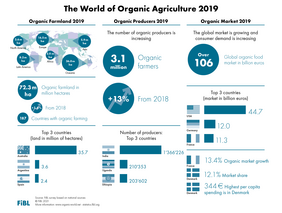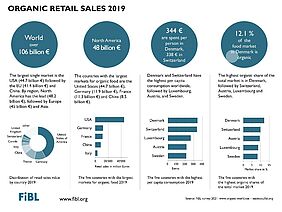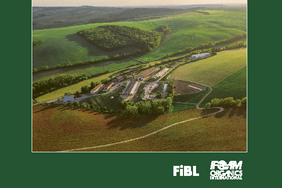(Frick, 17 February 2021) According to the latest FiBL survey on organic agriculture worldwide, organic farmland increased by 1.1 million hectares, and organic retail sales continued to grow, as shown by the data from 187 countries (data as of the end of 2019). The 22nd edition of the study "The World of Organic Agriculture" published by FiBL and IFOAM – Organics International shows a continuation of the positive trend seen in the past years. This annual survey on organic agriculture worldwide is supported by the Swiss State Secretariat for Economic Affairs (SECO), the International Trade Centre (ITC), the Sustainability Fund of Coop Switzerland and NürnbergMesse, the organizers of the BIOFACH fair.
The global organic market continues to grow
The global market for organic food reached 106 billion euros in 2019. The United States is the leading market (44.7 billion euros), followed by Germany (12.0 billion euros) and France (11.3 billion euros). In 2019, many major markets continued to show strong growth rates; for example, the French market increased by more than 13 percent. Danish and Swiss consumers spent the most on organic food (344 and 338 euros per capita, respectively). Denmark had the highest organic market share, with 12.1 percent of its total food market.
3.1 million organic producers worldwide
In 2019, 3.1 million organic producers were reported. India continues to be the country with the highest number of producers (1’366’000), followed by Uganda (210’000), and Ethiopia (204’000). The majority of small-scale producers are certified in groups based on an internal control system.
Steady increase of organic farmland
A total of 72.3 million hectares were organically managed at the end of 2019, representing a growth of 1.6 percent or 1.1 million hectares compared to 2018. Australia has the largest organic agricultural area (35.7 million hectares), followed by Argentina (3.7 million hectares), and Spain (2.4 million hectares). Due to the large area of organic farmland in Australia, half of the global organic agricultural land is in Oceania (36.0 million hectares). Europe has the second largest area (16.5 million hectares), followed by Latin America (8.3 million hectares). The organic area increased in all continents compared to 2018, except in Asia (mainly due to a drop in organic farmland reported from China) and Oceania.
Ten percent or more of the farmland is organic in 16 countries
Globally, 1.5 percent of farmland is organic. However, many countries have far higher shares. The countries with the largest organic share of their total farmland are Liechtenstein (41.0 percent), Austria (26.1 percent) and São Tomé and Príncipe (24.9 percent). Some states in India are or aspire to be 100 % organic in the coming years. In sixteen countries, 10 percent or more of all agricultural land is organic.
Global organic statistics show ongoing engagement with transparency in the organic sector
"The global organic statistics have proven useful for international development cooperation programs and supporting strategies for organic agriculture and markets, and they are crucial for monitoring the impact of these activities. This publication shows our ongoing engagement with transparency in the organic sector", says Louise Luttikholt, IFOAM – Organics International Executive Director. Knut Schmidtke, Director of Research, Extension & Innovation of FiBL Switzerland, adds "The yearbook is an outstanding reflection of the level of trust people around the world have in organic agriculture and its importance for nutrition, the environment and sustainable development."
COVID-19 has resulted in a significant increase in demand for organic products in many countries but also challenges: "We expect to see the effect of the pandemic on the development of the sector with the 2020 data to be ready in a year’s time", says Helga Willer, who is in charge of the yearbook at FiBL.
More information
How to order/download
The book can be ordered (30 euros + postage; affiliates of IFOAM – Organics International: 20 euros) or downloaded from the FiBL shop (order number 1150). Graphs and infographics can be downloaded at Organic-World.net.
- fibl.org: Dr. Helga Willer, Research Institute of Organic Agriculture FiBL
Ackerstrasse 113, 5070 Frick, Switzerland - Louise Luttikholt, IFOAM – Organics International
Charles-de-Gaulle-Strasse 5, 53113 Bonn, Germany
+49 (0)1575 769 11 01, Fax +49 (0)228 9265099, l.luttikholt(at)ifoam.bio, www.ifoam.bio
Programme of the session “The World of Organic Agriculture – Statistics and Emerging Trends” at BIOFACH eSPECIAL 2021
Wednesday, 17 February 2021, 4:00 to 4:45 pm (CET), Livestream 3
- Louise Luttikholt, IFOAM – Organics International, Deutschland, Moderator
- Barbara Jäggin, Swiss State Secretariat for Economic Affairs (SECO)
- Dr. Helga Willer, FiBL, Schweiz: Latest data on organic agriculture worldwide
- Cornelia Kirchner, IFOAM – Organics International, Standards and regulations
- Amarjit Sahota, Ecovia Intelligence, UK: The global market for organic food
More information:
biofach.de: Programme
Statistics sessions at the BIOFACH eSPECIAL 2021 at a glance
Wednesday, 17 February 2021
- The World of Organic Agriculture
4 to 4.45 pm, Livestream 3 - The European market for organic food
5 to 6 pm, Livestream 5
Thursday, 18 February 2021
Global Organic Market Overview – facts, trends and opportunities
2 to 3.30 pm, Livestream 3
Supporters of the yearbook "The World of Organic Agriculture"
- admin.ch: Swiss State Secretariat for Economic Affairs (SECO), Berne, Switzerland
- intracen.org: International Trade Centre (ITC), Geneva, Switzerland
- actions-not-words.ch: Coop Sustainability Fund, Basel, Switzerland
- nuernbergmesse.de: NürnbergMesse, the organizers of the BIOFACH fair, Nuremberg, Germany
Download
Media kit including this media release and further data and graphs (1.1 MB)
Media kit including this media release and further data and graphs (1.9 MB)






